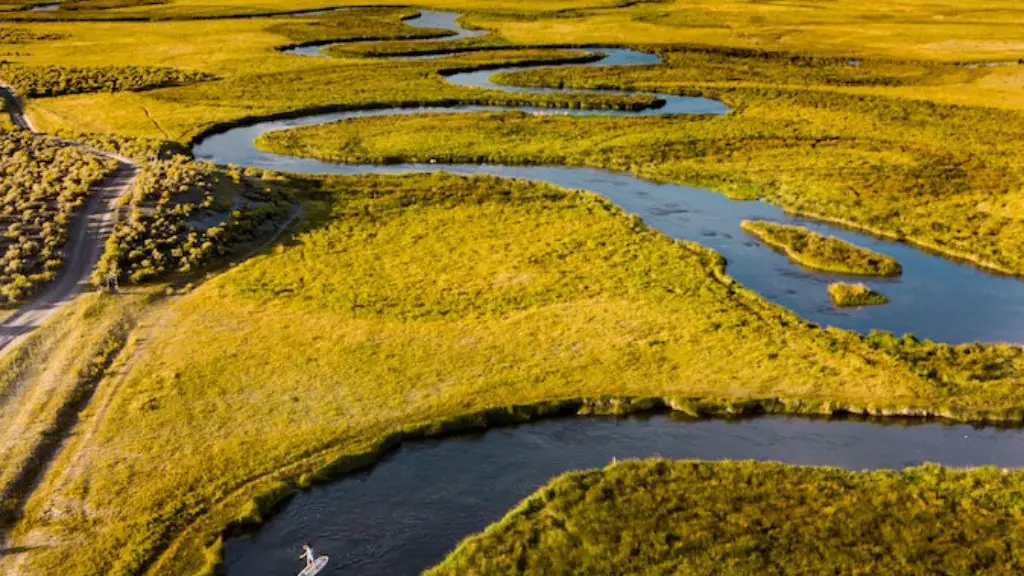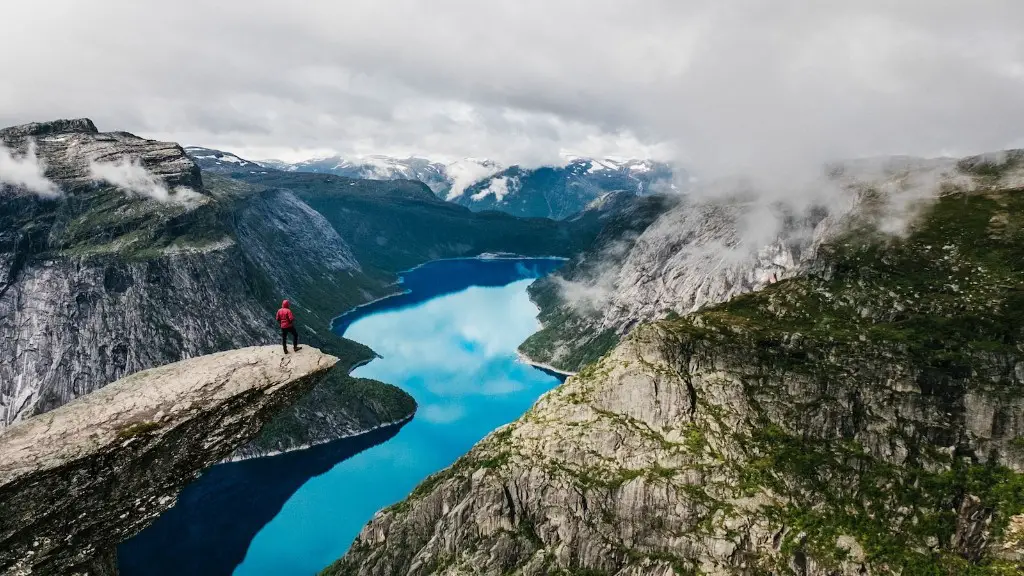Using The Nile River in Ancient Egypt
The Ancient Egyptians were one of the first societies to use their knowledge of water to build a great empire. In antiquity, the Egyptians drew power and prosperity from their incredible, world-spanning river, the Nile. Before the development of modern technologies, the Nile was an unmatched transportation route that served a vast agricultural network and an impressive array of cities. By understanding the importance of the Nile and learning how to use it, the Egyptians enjoyed an enviable level of comfort and prosperity.
From the earliest days of Egyptian civilization, the Nile River has been a symbol of life and a critical part of the Egyptian way of life. The Nile is not only an incredibly vital source of water for drinking, but also an excellent source of irrigation for growing crops. In addition, it was the main route of transportation throughout the country. This allowed people to easily trade goods and services, and also strengthened defense in times of war.
The Nile was essential to the entire agricultural landscape of Ancient Egypt. Its waters brought vital minerals up from the sea and fertilised the Egyptian land when it flooded each year. As such, Ancient Egyptians were known to praise the annual flooding, as it brought the life-giving waters they needed. Even the Pharaohs of Ancient Egypt were known to celebrate the flooding of the Nile with music and dance.
Without the Nile, there would not have been the great advances in science, technology, and culture that have been attributed to Ancient Egypt. The river provided the fresh water for bathing, drinking, and cooking, as well as the transportation, irrigation, and fertilisation necessary for trade, farming and domestic life. In addition, the fish from the Nile sustained people’s diets, and its silt created the dark rich soil needed for growing crops.
Experts believe that the Ancient Egyptians took full advantage of the Nile. They used nets and traps to catch fish, which were then dried and used for trading. Reeds were used to construct homes and boats. High banks were created to regulate the flow of water and to prevent floods. Ancient Egyptians even developed a skilful system of dams and canals to capture, control and redirect the Nile’s multitude of sources of energy.
The Ancient Egyptians also used the Nile for transportation. They travelled up and down river on boats, trading goods with other civilisations. The most popular goods traded were grain, pottery, and weapons. Navigation of the river was made easier with methods such as flaming torches and astronomical knowledge. The Egyptians also used the Nile to move their army on campaigns of conquest.
The relationship between the Ancient Egyptians and the Nile was complex and fascinating. This river was essential for the construction of civilization in Ancient Egypt, lending power, prosperity and life. It provided Ancient Egyptians with a way to travel, nourish their crops and trade with other cultures, as well as giving them a method for successfully defending their people and lands. Despite challenges, such as disease-carrying mosquitos and riverbank erosion, Ancient Egyptians managed to make the most of this critical waterway.
Religion and Ceremony
The Ancient Egyptians worshipped the Nile and believed it to be the source of all life. They built temples along the banks of the river to be near its life-giving waters. These temples were considered to be sacred spaces, which were visited by the Pharaohs and other important people. Rituals and ceremonies were performed to honour the Nile and to ask its blessing for prosperity and protection.
The Cult of Hapi was a famous cult worshipping the spirit of the Nile. It celebrated the annual flooding of the river, as well as the bounty which it brought. The Cult of Hapi also represented fertility and prosperity, and protected the people from natural disasters. It is likely that their worship of the Nile was linked to their belief in the afterlife, as they believed that the river offered a pathway to the afterlife.
The floods of the Nile were believed to bring good luck, fertility, and abundance. To celebrate the flood, grand festivals were held which included music, dancing, prayer, and offerings to the gods. One such festival was the great Feast of Khoiak, which lasted several days. This celebration happened each year in late October, and was a major event in the religious life of Ancient Egypt.
The banks of the Nile were also known to contain crocodiles, which were revered as sacred animals by the Ancient Egyptians. Crocodiles were frequently depicted in paintings, writing and jewellery, and some were even kept as pets. Statues and mummies of crocodiles were placed inside temples, and priests regularly worshipped and offered sacrifices to them.
Trade and Commerce
The Ancient Egyptians used the Nile to conduct trade with other civilisations. Goods such as grain, pottery, weapons, and animals were shipped up and down river via boats. This allowed for a flourishing trade economy, which made the kingdom richer and more powerful.
The development of the great harbour cities of Memphis and Thebes allowed the Egyptians to easily trade with neighbouring countries. Merchants travelling up and down the Nile exchanged goods and services with people of different cultures, leading to a flourishing economy. This allowed them to obtain resources and materials that they could not produce, as well as gain access to new technologies.
In addition to being used as a trade route, the Nile also played a role in government taxation. The Egyptians developed a way of measuring the water level of the Nile, which allowed them to accurately calculate taxes. This taxation system provided a consistent source of revenue for the government, helping to finance their numerous projects.
Apart from trade, the Nile was also critical for communication between cities and provinces. The Egyptians used it to move messages, trade information, and spread news. This allowed different people to keep in contact, even though they were living many miles away from each other.
The Ancient Egyptians were incredibly resourceful, and they took full advantage of the opportunities presented by the river. It was an irreplaceable asset that was essential for the growth, prosperity and stability of their civilisation. The Nile offered a lifeline to the people of Ancient Egypt, and was a key factor in the emergence of one of the world’s first great civilisations.
Technology and Innovation
The Egyptians harnessed the power of the Nile to develop innovative technologies. They had a deep understanding of how the river worked, allowing them to create ingenious systems to capture, control and redirect its energy.
The most significant example of this is the construction of the Aswan Dam. The dam was built to regulate the Nile’s flow, as well as to protect against floods. The Ancient Egyptians also developed sophisticated systems of canals and locks to redirect water to different areas. This allowed for efficient irrigation, and was critical for their agriculture.
The Egyptians were also incredibly advanced in shipbuilding and navigation. They constructed sailboats and barges that could navigate both up and down the river with ease. Astronomical knowledge and flaming torches were used to navigate the river at night, when visibility was poor.
The Egyptians also made use of the river in warfare. They developed ships called galleys which were used to transport their armies across the Nile. These ships were surprisingly large and fast, allowing them to easily manoeuvre in and out of dangerous waters. The Egyptians also employed catapults and ballistas to launch long-range attacks, although they were not as effective at sea as they were on land.
The Nile offered Ancient Egyptians an unprecedented level of comfort and prosperity. Through their ingenious engineering and resourcefulness, they were able to make the most of this miraculous river and build an empire that would last for centuries.
Impact on Society
The Nile shaped Ancient Egyptian society in many ways, from architecture and art to religion and economics. The river gave people a sense of security, as it provided a reliable source of water and food. It was also used for religious ceremonies, funerary rites and military campaigns. This gave people a sense of purpose and helped to create a strong sense of national identity.
The Ancient Egyptians were known to be excellent irrigators and hydrologists. They utilised the water of the Nile to create their own system of irrigation, which was an essential part of their agricultural economy. This system allowed for large-scale production of food which was necessary for sustaining the growing population.
The Nile was also a source of entertainment for the Ancient Egyptians. They used the river for fishing, swimming, and sailing. The riverbanks were also lined with dancing, music and storytelling. The Ancient Egyptians enjoyed the peace and relaxation that the Nile offered.
The Nile also played an important role in communication and transportation. Messages, goods and people could be quickly moved up and down river. This allowed for people to stay in contact and for goods to be traded between different cities and provinces.
In short, the Nile was an essential part of life in ancient Egypt. Its waters nourished and sustained the Egyptian people and their culture. The river was a source of security, entertainment and economic power, and its influence is still felt in modern Egypt today.
The Legacy of the Nile
The legacy of the Nile River is still strong in modern Egypt. It continues to be an important source of water and food, and is used for transportation and trade. As in Ancient Egypt, the annual flooding is still celebrated as a sign of life and abundance. The Nile is a powerful symbol of Egyptian identity and unity, and has made a tremendous impact on the culture and history of the country.
The Ancient Egyptians used their expertise and knowledge to build a great civilisation, and the Nile was an essential part of this. It provided the life-giving waters necessary for the growth of their culture and economy, as well as the transportation and trade necessary for its advancement. Despite challenges, such as disease-carrying mosquitos and riverbank erosion, the Ancient Egyptians managed to make the most of this critical waterway.
Today, the Nile is admired as a marvel of natural engineering, and its influence is still felt around the world. Ancient Egyptians were some of the first civilizations to understand its importance, and they used it to bring order, abundance and prosperity to their people. The Nile River is a testament to the genius and resourcefulness of the Ancient Egyptians, and its power and influence will continue to be felt for generations to come.





